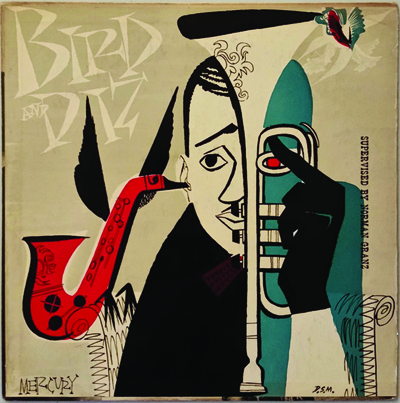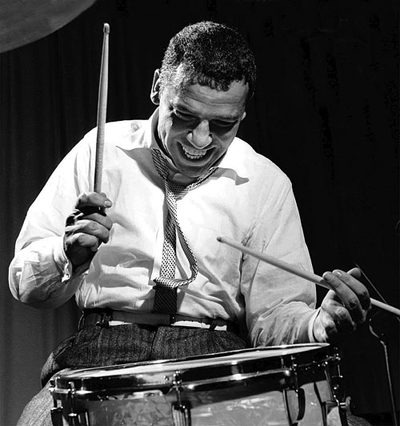Dancing to Buddy Rich’s Tune — A New Year’s Eve of High Winds, Thunder and Lightning
By Stuart Mitchner
At the dawn of a new year in American popular culture it’s time to remember the losses of 2017 and pay tribute to the gains of 1917. Major deaths in the world of rock were legends Fats Domino and Chuck Berry, along with Tom Petty, Greg Allman, John Wetton, among others, and in the grey area between rock and jazz, Allan Holdsworth and Larry Coryell. Jazz losses included pianist Horace Parlan, bop vocalist Jon Hendricks of the premiere word-jazz group, Lambert, Hendricks, and Ross, and Buddy Greco who began his jazz, pop, and country career at 16 playing piano, singing, arranging, and touring the world with the Benny Goodman band. The jazz world also lost columnist and social critic Nat Hentoff, who wrote for Down Beat and the Village Voice, and was listening to Billie Holiday when he died.
As for gains, the landmark year 1917 produced Ella Fitzgerald (1917-1996), Dizzy Gillespie (1917-1993), and Thelonious Monk (1917-1982), all celebrated in previous columns. One musician for the ages mentioned only in passing until now is Brooklyn-born drummer Buddy Rich (1917-1987), who joins centenary brothers Gillespie, Monk, and bassist Curly Russell (1917-1986) on Bird and Diz, a 1950 album led by Charlie Parker (1920-1955), whose vast charismatic 20th century presence transcends birth dates, leaving the specifics of time like so much stardust in his wake. Listen to the way he and Gillespie interact on the 330-beats-a-minute “Leapfrog” and you’d think they were born in the same year and rocked in the same cradle to the same lullabies, bearing out Parker’s words in a Down Beat blindfold test: “Dizzy Gillespie … the other half of my heartbeat.” Gillespie said it another way: “The moment I heard Charlie Parker, I said, there is my colleague.”
Both quotes are featured in jazz scholar James Patrick’s liner notes for Verve’s restored high-definition Master Edition CD of Bird and Diz, which includes all takes from the session as well as David Stone Martin’s cover art.
A One-Man Insurgency
Since jazz and New Year’s Eve are as natural a unit as jazz and New York, why not imagine this once-in-a-lifetime quintet setting up on the bandstand of the Royal Roost or Birdland, both clubs once located within five blocks of each other in the Times Square heart of Manhattan that was packed to overflowing with revellers on Sunday night.
Or better yet, let’s go back to 1939 when Swing was King and Buddy Rich was a star at 22, rousing dancefloor crowds to a frenzy with Artie Shaw’s big band. In the words of The New Yorker’s Whitney Balliett, a Buddy Rich drum solo was “Walpurgis Night. High winds. Thunder and lightning.” After the Faustian special effects, we learn that when “the greatest virtuoso in jazz drumming” joined Shaw’s band in December of 1939, “everything moved to a new level,” Rich “a one-man insurgency, constantly challenging, pressing and literally cheering the band on, sometimes with a wildly delightful lack of restraint.” You can see the master of revels in action on YouTube in “Traffic Jam” and “Everything’s Jumpin” (audio only), which he “pushes with a driving metallic snap, and caps with a wonderfully imaginative procession of rolls.”
Giving the superlatives a rest, Balliett comes down to earth to note that Rich is “overpowered by his astonishing gifts, a captive of his own virtuosity” with “little sense of taste, dynamics, and shading, and none of the elasticity essential to great drumming.” His solos go on “far too long” and “he is a peculiarly dull accompanist.”
One of the great jazz critics, Balliett knows more about Rich than I ever will, but he surely can’t have been talking about the drumming on Bird and Diz. James Patrick’s otherwise informative CD liner notes take the standard line that Rich’s style is somehow out of sync with bop: he is “intrusive” and should have been replaced by a “Max Roach, Roy Haynes, or Kenny Clarke.” Bird knew better. All you need to see is the YouTube clip of “Celerity” where Parker smiles a smile big enough to contain an eternity of liner note writers as he watches Rich hammer out high winds, thunder, and lightning. Patrick’s replacement advice is also roundly dismissed in Samuel Schell’s All About Jazz review from 2007: “Rich may be less flowing and propulsive than the aforementioned bebop drummers, but he’s definitely not intrusive. In fact, his swing-era symmetry and unfailing metronomic pulse bring a different dimension to the music and complement, above all, Monk’s clockwork. It begs credulity that a musician like Monk would have hung around the studio if he didn’t appreciate Rich’s time.” In Jazz Masters of the 1940s, Ira Gitler quotes Gillespie admiring the way Rich is able to integrate “all the different components of the drum set and yet still keep the bass-drum rhythm going.”
In the wild back and forth of “Leap Frog” Rich more than holds his own, although that’s not the performance I had in mind when I raised my eyebrows at Balliett’s “dull accompanist” comment. Rich’s work on Norman Granz’s Jam Sessions 3 and 4 skewers sterile terms like accompanist. It makes no sense to put so passive a word anywhere near the tempered passion of Rich’s unrelenting, brilliantly balanced, ever subtle contribution to a pair of 1953 all-star sessions featuring soloists like tenor sax men Wardell Gray and Stan Getz, alto sax wizards Benny Carter and Willie the Lion Smith, clarinetist Buddy DeFranco and trumpeter Harry Sweets Edison. From the time I heard “Oh Lady Be Good” and “Apple Jam” as a teenager, I had no doubt that the musical euphoria of inspired playing amid deliriously riffing ensembles was riding on a rhythmic absolute driven by the irresistible, madly swinging beat laid down by Rich in tandem with Count Basie’s piano, Freddie Greene’s guitar, and John Simmons’s bass. Taking no solos himself beyond a brief, electric, fiercely flashy show of force in “Lady Be Good” (you can hear the live wire crackling), Rich simply drives and drives and drives until you feel it the way you do the engine humming under you when you bond with a car on a dream of a road at night.
Faces in the Crowd
On New Year’s Eve, truth be told, I prefer a one-man insurgency to understated artistry. Give me the manic 22-year-old beaming at the crowd as he kicks off “Traffic Jam” in that M-G-M clip from the early Lana Turner movie Dancing Co-Ed (1939). As the camera moves from Rich to the horns and saxes to Shaw wailing on clarinet, the big-band dynamic transcends time and place. No matter that the styles of dance and dress look dated and the war is looming, the excitement is timeless, the music alive in the dancing of tuxedo-suited men twirling and whirling girls dressed to the nines — it may not be in the same league as the Black Bottom at the Savoy but it’s all you know and all you need to know on a “what-fools-these-mortals-be” midsummer night’s dream of New Year’s Eve.
Ella Fitzgerald was 22 in 1939 and already had a breakthrough hit with “A Tisket A Tasket” while Diz and Bird and Monk, as well as Lena Horne (1917-2010) and Joan Fontaine (1917-2013), were still unknown. Dial it forward to 1950, everyone’s 33, Lena’s moving the world with “Stormy Weather,” Fontaine’s inhabited Jane Eyre, copped an Oscar for Suspicion, starred in Max Ophuls’s masterpiece, Letter from an Unknown Woman, and played against type in Born To Be Bad opposite Mel Ferrer (1917-2008); that’s him toasting Oscar winner Jane Wyman (1917-2007), who’s ready for some serious fun, having just divorced Ronald Reagan. Off in a corner film-noir-incarnate Robert Mitchum (1917-1997) is sharing a joint with all-in-black B-western hero Lash Larue (1917-1996). And there’s Desi Arnaz (1917-1986) flirting with some showgirls while Lucille Ball, his senior by six years, talks shop with Howdy Doody’s Buffalo Bob (1917-1998); next year will see the debut of her top-rated sitcom I Love Lucy. There are odd couples galore, like literary critic Leslie (“Come Back to the Raft Again Huck Honey”) Fiedler dancing with Zsa Zsa Gabor (1917-2016) while lean and hngry Robert Lowell (1917-1977) flailingly tries to cut in. Singer Joan (“You Belong to Me”) Stafford (1917-2008) is on her way to the bandstand to say hi to Buddy Rich, a cohort from her days with Tommy Dorsey. That looks like Dean Martin (1917-1995) swaying in the same direction: he’s mistaken the drummer for his monkey sidekick Jerry Lewis. Oh, the guy with a sketch pad in the balcony is Andrew Wyeth (1917-2009), and last but definitely not least, arriving just in time for the midnight moment with June Allyson (1917-2006) and Celeste Holm (1917-2012) on either arm is the Congressman from Massachusetts Jack Kennedy (1917-1963).
“Talking About Spirit”
Interviewed by drummer Art Taylor about the way musicians “embellish one another,” Dizzy Gillespie recalls “the big embellishment” when his band was playing with Ella Fitzgerald and “Bird walked out onto the stage with one big red rose, handed it to me and kissed me right on the mouth and walked off. Ooooow! Talking about spirit, how deep can you get? I don’t care how far you go, there is no deeper.”
So here’s wishing everyone a happy 2018, with farewell toasts to Larry Ivan (1932-2017), who taught my son to swim and always watched out for him; my Town Topics colleague Fritz Marston (1940-2017), who shared a feeling for the ending of Chaplin’s City Lights with me at a Christmas party years ago; and, speaking of spirit, a special goodbye to the ever-spirited Peter Gruen (1943-2017), who, with his wife Anne Elliott, shared two 21st century New Years Eves with my wife and me.



